- Introduction
- Why express breastmilk?
- How does expressing maintain breastmilk supply?
- Who expresses breastmilk?
- When can a woman begin expressing breastmilk?
- How often should breastmilk be expressed?
- How much breastmilk should be expressed?
- How is breastmilk expressed?
- Expressing breastmilk at work
- Expressing breastmilk in hospital
- How long does it take to express breastmilk?
- Storing and labelling expressed breastmilk
- Transporting expressed breastmilk
- Reheating and feeding an infant with expressed breastmilk
- Benefits of expressing breastmilk
- Limitations of expressing breastmilk
Introduction
Expressing breastmilk refers to the process by which a woman expels milk from her breast. The breastmilk can then be stored and fed to her baby at a later point in time. Milk may be expelled manually using the hands or with a pump especially designed for expressing breastmilk.
Why express breastmilk?
The best way of providing a baby with breastmilk is to breastfeed, but for various reasons this may not always be possible. For example, the mother may need to be separated from her infant to go to work or the infant may be hospitalised away from the mother. At these times, expressing breastmilk enables a woman to feed her baby with the substance which provides optimal nutrition (breastmilk) even though she is separated from the baby. For women who need to be separated from their baby for more than a few hours, expressing breastmilk is required to ensure that the mammary glands (the glands in the breast which produce milk) continue to produce a sufficient quantity of milk to provide for the baby’s nutritional requirements.
How does expressing maintain breastmilk supply?
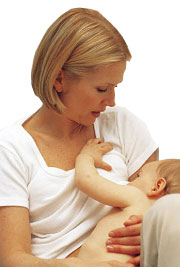
When a baby suckles (or milk is encouraged to leave the breast by another means, such as expressing milk), the pituitary gland is stimulated to produce a hormone called oxytocin. Oxytocin regulates the secretion of milk from the breast and stimulates the ‘let-down reflex’, the reflex which enables milk to leave the breast. The presence of oxytocin also signals the pituitary to secrete a second hormone, prolactin, which stimulates the production of more milk in the breast.
In order for a woman to maintain a constant supply of breastmilk sufficient to enable exclusive breastfeeding, milk must be removed from the breast regularly. Frequent breastfeeding, whenever the baby demands feeding (for example by becoming restless) is the best way to maintain an adequate supply of breastmilk. However, some women are unable to breastfeed frequently or when their baby demands because they are separated from their baby. In these instances, expressing milk enables a woman to maintain her breastmilk supply, as like baby suckling, expressing breastmilk also stimulates the production of more milk.
Who expresses breastmilk?
There are many reasons a woman may need to express breastmilk rather than feed her baby directly from the breast. Some women may express breastmilk regularly, while others may do so only from time to time. Reasons why a woman might choose to express breastmilk include:
- The baby has difficulty suckling, for example because it was born premature or is unable to attach to the breast;
- The baby is hospitalised and the mother is unable to be in hospital at all the infant’s feeding times;
- The woman is hospitalised and it is not possible for the baby to be brought to her for each feed;
- The woman is working and needs to be separated from the baby to go to work;
- The baby is being looked after temporarily by another person, for example a babysitter is caring for the baby so that the parents can have a night away;
- The woman’s breasts feel too full or engorged at times when the infant does not wish to feed. This can cause discomfort and expressing milk can reduce the discomfort;
- The woman wants to keep a little breastmilk stored in the freezer in case there is an emergency which requires her to separate from the infant;
- The woman has a condition such as mastitis (infection of the breast tissue) or a blocked duct. These women are advised to ensure their breasts are completely emptied after each breastfeeding session and it may sometimes be necessary to express milk after the baby has finished suckling, to ensure that the breasts are completely empty;
- The woman’s nipples are cracked or damaged and need a period free of suckling to heal;
- The woman’s milk supply is low, in which case expressing milk can stimulate further production of breastmilk;
- The woman wishes to provide her infant breastmilk but does not wish to suckle.
When can a woman begin expressing breastmilk?

In the first week or so after childbirth, when lactation is still being established, it is recommended that women express milk by hand. However, they may commence using a pump once their breasts start to feel full, indicating that breastmilk production is fully established.
How often should breastmilk be expressed?
The regularity with which a woman should express breastmilk will depend on the age of the baby and her reasons for expressing. If a woman commences expressing milk immediately after childbirth in order to establish breastmilk production (e.g. because her infant is not suckling), she will need to express milk regularly (8-10 times per day or as frequently as every 1.5 hours). Once lactation is established, less frequent expressing (e.g. every 3-4 hours or 6-8 times a day) is usually sufficient to maintain sufficient breastmilk production. Women who regularly express breastmilk should be aware that that expressing frequently (including during the night) is more effective in stimulating breastmilk production than expressing less frequently.
Women who typically suckle their infant and only express periodically (e.g. for a night out or a day away once in a while) need only express breastmilk as often as they need to leave a supply for infant feeding. Those who do so because of breast discomfort can express milk only at the times when their breasts are feeling too full.
Women who are expressing excess milk due to conditions such as mastitis or blocked ducts should express as much remaining milk from their breast as possible, each time the baby suckles.
Those who are expressing in an attempt to increase their supply of breastmilk should express milk from each breast until empty, 2-3 times per sitting (in a row), as this will help to establish a larger supply of breastmilk over time.
Women who have missed suckling their infant or expressing their milk one or more times may try expressing several times in close succession, in order to ensure a minimum of six milk expresses for the day. This will help to maximise their milk supply.
How much breastmilk should be expressed?
The correct amount of breastmilk to express varies, depending on the woman’s reason for expressing breastmilk and the amount of milk she is able to express. Once breastmilk production is fully established, some women manage to express 90-120ml of milk from each breast, every 3-4 hours. Others find it easier to express smaller amounts of milk, less frequently. Women who are expressing should be aware that the amount of milk expressed in a sitting is not necessarily as great as the amount of milk produced in the breast. A small proportion of women who produce sufficient milk to suckle their baby exclusively (provide their baby with breastmilk only and no other foods), are unable to express milk. This is because expressing is a less efficient technique of removing milk from breasts compared to a baby suckling.
The following table provides a rough guide regarding how much breastmilk a woman should express, depending on her circumstances and reasons for expressing. Women who express less breastmilk than they might be expected to and who feel that the amount of milk they express is insufficient, should discuss their concerns with a health professional, for example their general practitioner.
| Reason for expressing | Amount of milk which should be expressed |
| Breasts are engorged or uncomfortable because they are too full | Express only as much breastmilk as is required to reduce the feeling of engorgement or discomfort. |
| Blocked duct or mastitis | Express as much breastmilk as possible after the infant has finished suckling. |
| To store breastmilk for emergency use | Express as much milk as is needed for storage |
| For regular infant feeding | Express as much milk as possible and fully drain both breasts each time. In the first days after childbirth it may only be possible to express a few drops or a few mls of breastmilk. 4-5 days after childbirth it is typical for women to express 50-70mls from each breast, each time they express, increasing to 80-120ml by the end of the first week. Once regular breastmilk production is established women express 440-1,200ml of breastmilk each day. Women who sometimes suckle their infant (e.g. when they are not at work) may also wish to try expressing a little breastmilk after each suckling. It is important to note that the quantity of milk a woman is able to express differs from day to day and one breast often expresses more milk than the other. |
How is breastmilk expressed?

- Find a comfortable place to express breastmilk which is relaxing, warm and free of distractions. This may be the place in which the woman usually suckles the baby. Women who work will need, and have a right to negotiate with their employer to make such a space available;
- Consciously attempt to relax as milk will be easier to express when the woman is relaxed. Those who have difficulty relaxing while they express might try to:
- Breathe slowly and deeply;
- Have a warm drink just before expressing milk;
- Listen to soft, relaxing music;
- Have a warm shower just before expressing;
- Place a warm towel on the breast for several minutes before trying to express;
- Gently massage the breast and nipple to encourage the let-down reflex (the reflex which stimulates the secretion of breastmilk, by stimulating the release of oxytocin which causes the cells around milk ducts to expand and push milk from the breast);
- Express milk gently to avoid pain and discomfort;
- Express milk frequently as this will help establish breastmilk production and result in the production of greater quantities of breastmilk compared to less frequent expressing;
- Think about the infant and the benefits breastmilk will provide as this encourages the let-down reflex which triggers secretion of breastmilk. In order to encourage thoughts about their baby woman might wish to:
- Sit near or in skin contact with the baby if possible;
- Express milk just after separating from the baby (e.g. if the baby is being bottle fed expressed milk in hospital);
- Look at a photo of the baby;
- Have something to eat before commencing expressing milk, as this will ensure adequate energy and nutrients are available for the production of breastmilk;
- Have a glass of water handy to sip on whilst breastfeeding;
- Maintain a healthy, balanced diet while breastfeeding as breastmilk production is dependent on the availability of maternal nutrients. It is important not to skip meals and to drink at least 6 glasses of water per day;
- Find a support person to provide encouragement, such as your partner, a friend, relative or a health professional such as a counsellor.
Regardless of the method of expressing used, it is important that women maintain good hygiene when expressing breastmilk, in order to reduce the risk of infant infection. They should:
- Wash their hands thoroughly prior to commencing;
- Sterilise the cups and sealed bottles in which expressed milk will be stored and their components (e.g. lids), prior to commencing expression;
- Ensure that their hands do not touch the inside of containers used for storing breastmilk;
- Sterilise the breastmilk pump and its components if such a device will be used to help express the milk;
- Store breastmilk in the fridge immediately after expressing.

Ideally a woman should learn hand expressing techniques from midwives or other health professionals before being discharged from hospital. For hand expressing, women may be advised to:
- Wash their hands thoroughly before commencing;
- Begin by massaging the breast and nipple for a couple of minutes to encourage the let-down reflex;
- Place the thumb and index finger of one hand on either side of the areola of the breast (the darkly coloured section surrounding the nipple), well back from the nipple from which the milk will be expressed;
- Move the thumb and index finger, first pressing them back into the breast and then squeezing them together behind the nipple for about two seconds;
- Continue moving the thumb and index finger in the above motion, until milk begins to secrete from the nipple;
- When the flow of milk ceases, move the thumb and index finger to a different position on the areola of the same breast;
- Move the thumb and forefinger in the above described motion again;
- Repeat the motion using up to five different positions on the areola, until the flow of breastmilk ceases. It is important to empty the first breast before starting to express from the second breast;
- Repeat for the other breast.
- If milk is being expressed because the supply is low, the woman should express milk from each breast until it is empty, 2-3 times in a row.
Expressing breastmilk by hand should not cause pain or friction. Breasts should be manipulated in a gentle manner so as not to cause pain. Adding a few drops of breastmilk to each nipple following expression, and allowing the milk to air dry, may reduce nipple pain.
Expressing breastmilk using a pump
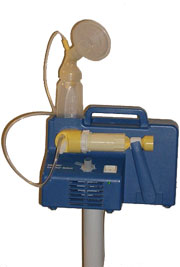
Women who use breast pumps must take particular care to ensure the pump is clean before use. To clean a breast pump women should:
- Begin by thoroughly washing and drying their hands
- Disassemble the breast pump fully, ensuring that all the pieces have been separated;
- Rinse each piece of the breast pump which has been in contact with the breast or breastmilk in cold water;
- Using a brush which is only used for cleaning the breast pump (and not for washing dishes or other purposes), remove all grease, milk and dirt from the pieces using a small quantity of dishwashing liquid;
- Rinse all the parts in hot water, twice;
- Drain and dry the pieces of the breast pump on a clean paper towel and cover the drying pieces with another sheet of paper towel;
- Once dry, store the kit in a clean plastic container, plastic wrap or paper towels to prevent contamination.
Women who express breastmilk regularly throughout the day do not need to disassemble their entire breast pump each time they express. They should rinse (in cold water) the components of the pump which come into contact with the breast or breastmilk after every expressing session, however only need to clean the pump thoroughly, according to the above instructions, once a day.
Some women may also wish to sterilise their breast pump from time to time, either by boiling or using a commercially available sterilising solution. However, it is recommended that women whose babies are sick and hospitalised sterilise their breastmilk pump everyday to reduce the likelihood of infection.

- Clean the pump thoroughly before the first use, even if it is brand new. Women should also ensure that the pump has been cleaned according to the above instructions (either rinsed or washed thoroughly since the last expression, depending on the regularity with which the woman expresses her milk);
- Assemble the pump according to the manufacturer’s instructions;
- If the pump is electric, set the pump to the lowest sucking action;
- Sit down and consciously try to relax before attaching the pump to the breast;
- Attach the cup to the breast from which milk is to be expressed, ensuring that the nipple is in the centre of the cup and there is good skin contact between the cup and breast;
- Start the pump. If the pump is electronic this means turning it on. For a manual breast pump, women should begin gently pumping the suction device of the pump;
- If the nipple hurts when the pump begins, remove the cup and check the nipple is properly positioned at the centre of the pump;
- If the cup feels comfortable, increase the suction to a higher setting on an electric pump, or pump the suction device more strongly (but not more quickly) for a manual pump;
- Leave the cup in place until the breast has been emptied;
- Repeat the above steps for the second breast.
Women should keep their pump upright while they are expressing to prevent milk flowing into the suction tubes and damaging the device.
Some women find it is useful to spend a couple of minutes expressing milk from their breasts by hand after using a breast pump. This helps ensure that the breast is fully drained. This is particularly important for women who are concerned that they are producing insufficient breastmilk, as completely draining the breast at each expression encourages greater breastmilk production.
Women using a single cup breast pump sometimes find it useful to change breasts several times during an expressing session (rather than completely draining one breast before commencing to express from the other).
Expressing breastmilk at work
In order to provide their baby exclusively with breastmilk, some women will need to express milk while they are working. Breastfeeding friendly workplaces incorporate facilities for expressing and storing milk, as well as for breastfeeding.
More information about Breastfeeding at Work.
Expressing breastmilk in hospital
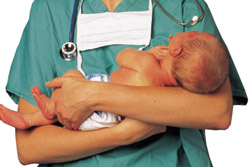
- Labelling the infant’s hospital chart to indicate it is being breastfed with expressed milk;
- Providing sterile bottles in which breastmilk can be stored;
- Providing expressed breastmilk labels for the bottles in which breastmilk will be stored;
- Providing facilities for storing breastmilk in the hospital ward in which the baby is admitted. Women who leave stored breastmilk at the hospital should ensure it is correctly labelled (see below) and also discuss with the nurse how much breastmilk should be expressed and left for the infant, before leaving the hospital;
- Keeping a record of how much breastmilk a woman has stored, so that she can easily determine whether or not she needs to express milk before leaving the hospital;
- Providing breast pumps for hire or in the ward.
How long does it take to express breastmilk?
In the initial stages expressing milk from both breasts usually takes 20-30 minutes. As expressing progresses and more milk is produced, the time taken to express the entire contents of each breast may increase. However, it should be noted that techniques for expressing breastmilk are not as efficient as a baby’s suckling action and expressing breastmilk therefore typically takes longer than suckling an infant.
Storing and labelling expressed breastmilk
Once expressed, it is important that breastmilk is stored correctly to prevent it perishing. It is important to ensure sterile containers are used for storage. They should be sealed with a lid and not the teat of the bottle, as the hole in the teat can allow entry of bacteria into the container.
It is important for women who are expressing to note that the colour and consistency of breastmilk and colostrum differs between women, so they should not become concerned if their milk looks different to the milk of other women. Women should also be aware that it is normal for breastmilk to separate upon standing, with a creamy layer forming at the top.
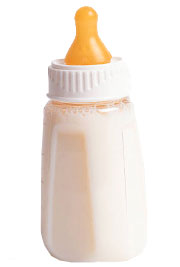
- An indicator that the container contains expressed breastmilk. Labels provided to women expressing milk for use in hospital will already be labelled as such;
- Name of the mother or baby;
- Ward in which the baby is admitted (if milk is expressed for use in hospital);
- Time expressed in 24 hour time or using am/pm;
- Date expressed;
- Use by date;
- Whether or not and when the milk was frozen;
- If previously frozen, the date on which the milk was thawed;
- Use by date after thawing.
Storage temperatures and times
The temperatures and length of time for which breastmilk can be stored vary, depending on whether the milk is freshly expressed or has been refrigerated, frozen or reheated since being expressed from the breast.
Fresh breastmilk is ideal, as freezing breastmilk destroys some of its benefits, but even after freezing, breastmilk remains the best source of nutrition for a baby.
Breastmilk should be stored as follows:
- Freshly expressed breastmilk can be stored at room temperature (<26°C) for 6-8 hours but should ideally be stored in a refrigerator immediately. If stored in a refrigerator (<4°C) breastmilk should be placed at the back (not in the door) and will remain fresh for 2-5 days. It is also possible to freeze freshly expressed milk in an internal fridge freezer (up to 2 weeks), a fridge freezer with a separate door (3 months) or a deep freeze (6-12 months).
- Previously frozen breastmilk, thawed in a refrigerator can be stored at room temperature for up to four hours after thawing or in the refrigerator for 24 hours. Previously frozen breastmilk should not be re-frozen.
- Previously frozen breastmilk, thawed in warm water can be stored for up to four hours at room temperature or for 24 hours in a refrigerator, as long as the infant has not commenced feeding. Once the infant begins to feed, the thawed breastmilk should only be kept for the duration of feeding. Any excess milk should be discarded after the feed. Previously frozen breastmilk should never be refrozen following thawing.
Transporting expressed breastmilk
Women who express breastmilk at work need to transport the milk to their home so that they can use it for infant feeding. Women may also need to transport their milk from home to hospital or childcare facilities. Ideally breastmilk should be transported in a cooled insulated container such as an esky or cooler bag. The cooler should contain ice to keep it cool.
Reheating and feeding an infant with expressed breastmilk
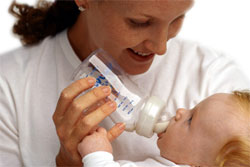
Previously refrigerated breastmilk
If breastmilk has been cooled it should be heated in a container of warm water prior to infant feeding. It should not be put in a microwave or heated directly, as over-heating kills many of the nutrients in breastmilk. The milk should be heated for several minutes (not more than ten) or until it feels cool-comfortably warm when dripped onto the wrist. Once reheated, any unused breastmilk should be discarded. It should not be re-used.
Previously frozen breastmilk should be thawed either in a refrigerator (in which case it can be stored in a refrigerator for up to 24 hours) or in warm water (in which case it should be used immediately and any excess discarded). Once thawed, breastmilk should be reheated (but only once, after which any remainder should be discarded) in the same fashion as previously refrigerated breastmilk.
Benefits of expressing breastmilk
The benefits of expressing breastmilk include:
- Expressed breastmilk, like suckled breastmilk, provides a baby with optimal nutrition;
- Breastmilk also protects a baby’s health by providing maternal antibodies which boost the baby’s immune system. It may also reduce the chance of infection as it is a hygienic food source (whereas water used to mix formula may be contaminated);
- Expressing breastmilk for infant feeding is a way in which mothers can be involved in their baby’s care, even if they are unable to suckle;
- Expressing breastmilk may enable the continuation of breastfeeding after periods of illness which prevent a baby suckling, as well as in other circumstances which might otherwise prevent breastfeeding (e.g. when the mother works);
- Expressing milk helps to maintain the mother’s breastmilk supply.
Limitations of expressing breastmilk
The limitations associated with expressing breastmilk include:
- Expressing breastmilk is less efficient compared to the action of an infant suckling, which means that women may not produce as much milk as they would if they were suckling their infant;
- Expressing breastmilk reduces the contraceptive effect of breastfeeding, as it does not stimulate the secretion of hormones which prevent ovulation to the same extent that a baby’s suckling does. While expressing may be adequate to maintain the breastmilk supply, some of the contraceptive effects of breastfeeding are lost when women express, compared to when they breastfeed. This means that women relying on the Lactational amenorrhoea method of contraception have a higher risk of pregnancy if they are expressing milk, compared to if they are suckling their infant. These women may require an alternative form of contraception, such as progesterone-only contraceptive pills or injection, which can be safely used by lactating women.
 |
For more information on breastfeeding including nutrition and contraception during breastfeeding and useful animations, see Breastfeeding. |
References
- National Health Service. Expressing Breastmilk. 2009. [cited 2010, April 13]. Available from: http://www.nhs.uk/Planners/birthtofive/Pages/Expressingbreastmilk.aspx
- Australian Breastfeeding Association. Expressing and storing breastmilk. 2003. [cited 2010, April 15]. Available from: http://www.breastfeeding.asn.au/bfinfo/express.html
- National Health and Medical Research Council. Dietary guidelines for children and adolescents in Australia, incorporating the infant feeding guidelines for health workers. 2003. [cited 2010, March 25]. Available from: http://www.nhmrc.gov.au/_files_nhmrc/file/publications/synopses/n34.pdf
- Royal Women’s Hopsital. Breastfeeding: expressing breastmilk. 2008 [cited 2010, April, 12]. Available from: http://www.thewomens.org.au/Expressingbreastmilk
- Royal Women’s Hospital. Breastfeeding or expressing in hospital. 2008. [cited 2010, April 12]. Available from: http://www.rch.org.au/kidsinfo/factsheets.cfm?doc_id=8388
- King Edward Memorial Hospital. Expressing breastmilk for your baby in the NCCU. 2009. [cited 2010, April 10]. Available from: http://www.kemh.health.wa.gov.au/brochures/consumers/wnhs0454.pdf
- Australia Breastfeeding Association. Negotiating with you employer. 2010. [cited 2010, April 15]. Available from: http://breastfeedingfriendly.com.au/index.php?option=com_content&task=view&id=25&Itemid=39
- Australian Breastfeeding Association. Suggestions on using an electronic breast pump. 2009. [cited 2010, April 13]. Available from: http://www.breastfeeding.asn.au/bfinfo/pumpsug.html
- Royal Women’s Hospital. Breastfeeding in hospital- expressing breastmilk for your baby in hospital. 2008 [cited 2010, April 10]. Available from: http://www.rch.org.au/kidsinfo/factsheets.cfm?doc_id=8523
- Royal Women’s Hospital. Using a breast pump. 2008. [cited 2010, April 13]. Available from: http://www.thewomens.org.au/Usingabreastpump
- Royal Women’s Hospital. Breastfeeding in hospital- Transporting and storing expressed breastmilk for hospital. 2006. [cited 2010, April 10. Available from: http://www.rch.org.au/kidsinfo/factsheets.cfm?doc_id=8524
- National Health Service. Breastfeeding and work- information for employers and employees. [cited 2010, March 30]. Available from: http://www.breastfeeding.nhs.uk/en/materialforclients/downloads/leaflet_4.pdf
- King, J. Contraception and Lactation. J Midwifery Women’s Health. 2007; 52(6): 614-20.
All content and media on the HealthEngine Blog is created and published online for informational purposes only. It is not intended to be a substitute for professional medical advice and should not be relied on as health or personal advice. Always seek the guidance of your doctor or other qualified health professional with any questions you may have regarding your health or a medical condition. Never disregard the advice of a medical professional, or delay in seeking it because of something you have read on this Website. If you think you may have a medical emergency, call your doctor, go to the nearest hospital emergency department, or call the emergency services immediately.







